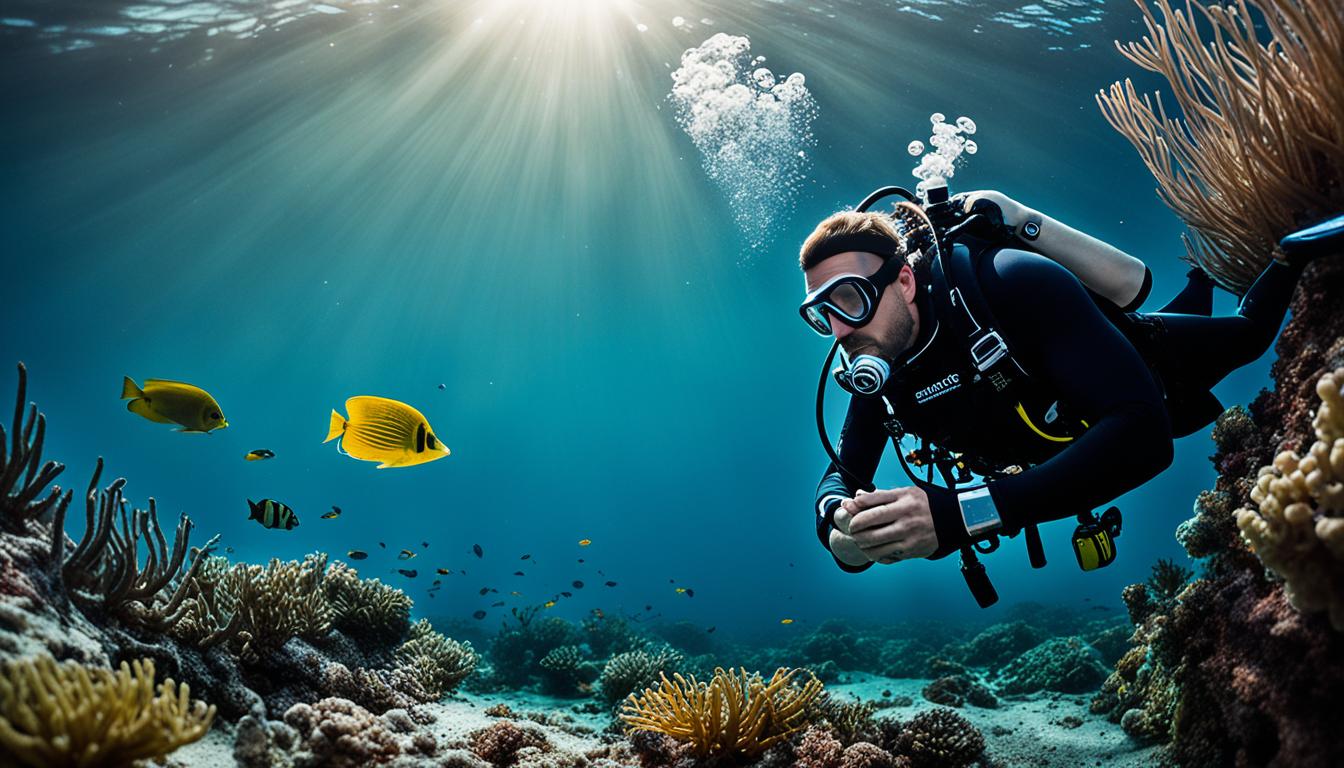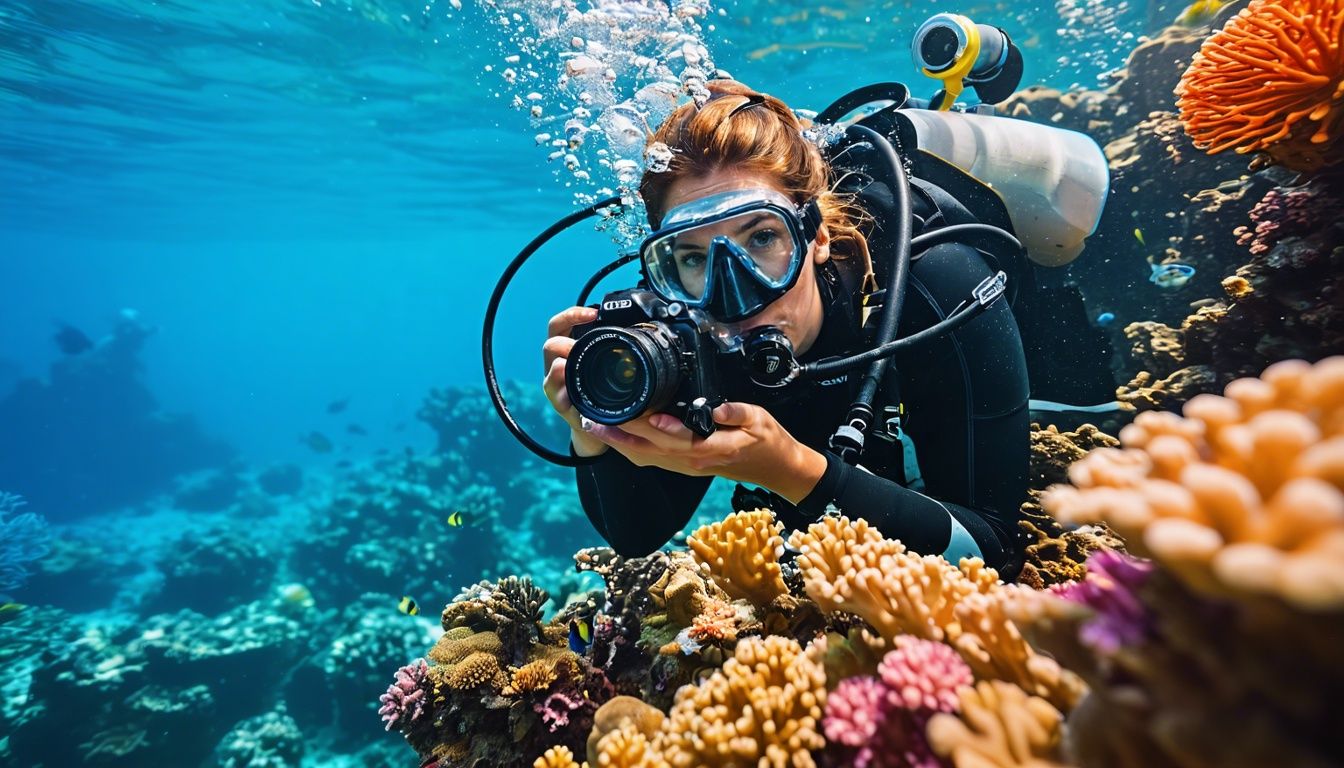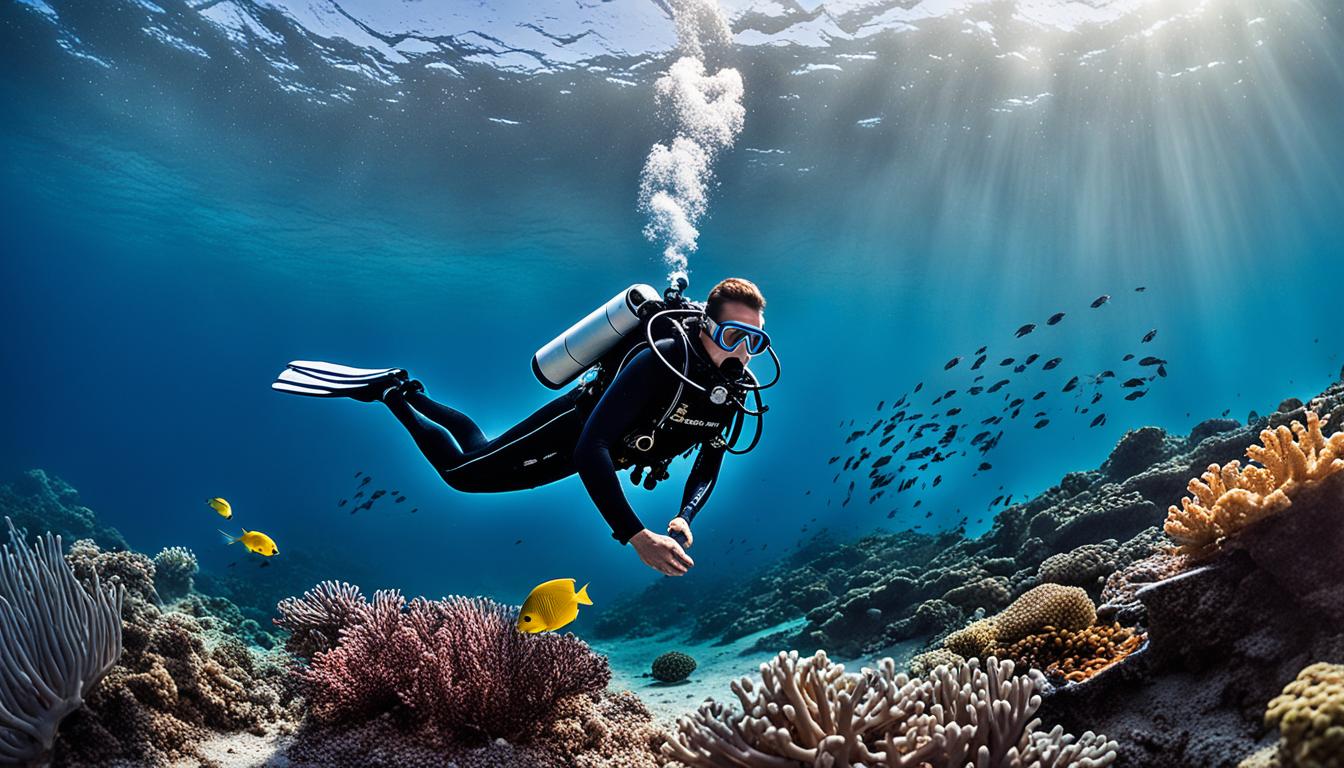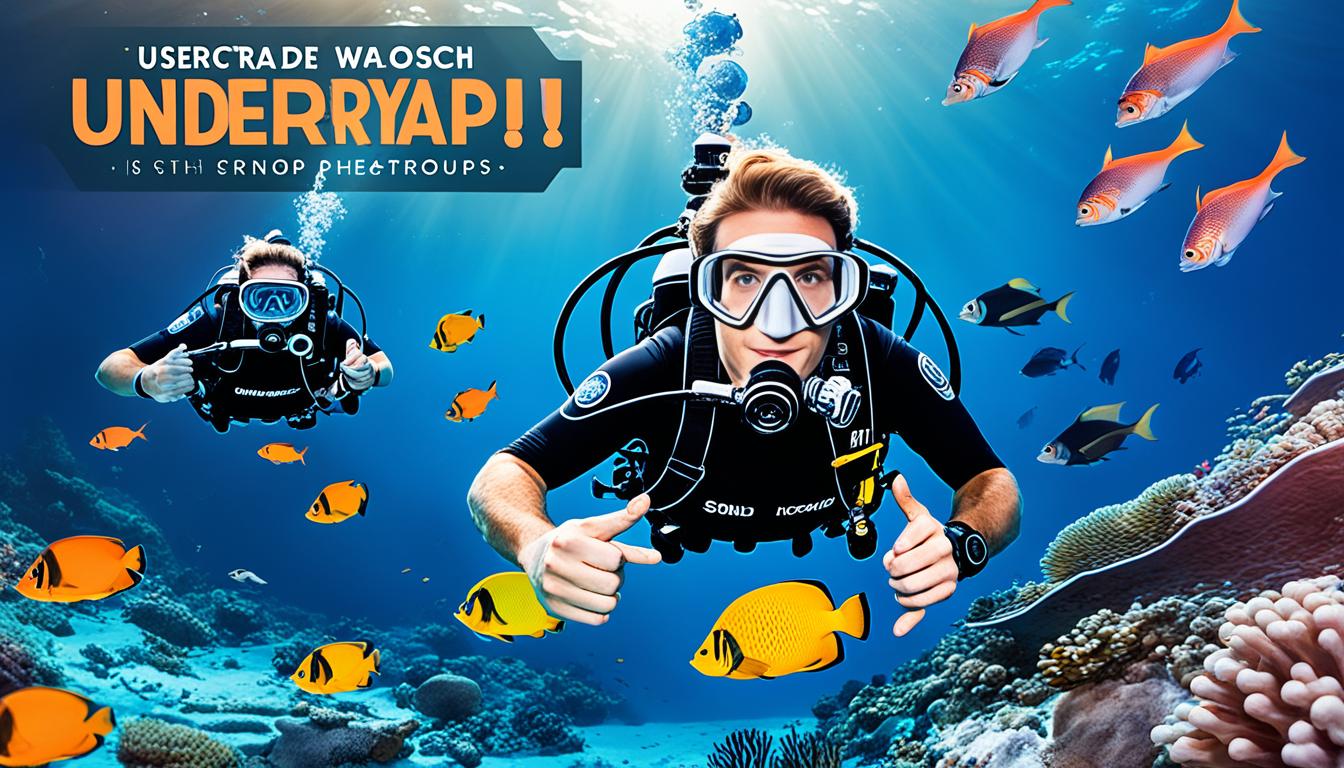Underwater photography is an exhilarating form of capturing images beneath the surface of the water. Whether you’re exploring freshwater lakes or diving into the depths of saltwater oceans, each environment presents unique challenges and opportunities for aquatic photography. In this section, we’ll dive into the nuances of underwater photography in both freshwater and saltwater environments and provide expert tips to help you capture stunning underwater images.
Key Takeaways:
- Understanding the differences between freshwater and saltwater underwater photography is crucial for optimizing your techniques and equipment.
- Choosing the right camera and lens options based on the environment can significantly impact the quality of your underwater images.
- Proper lighting and adjusting camera settings according to the shooting conditions is essential for achieving optimal results.
- Planning your shots, taking multiple images, and experimenting with different techniques can help you capture unique and captivating underwater photos.
- With the right knowledge and practice, you can showcase the breathtaking beauty of both freshwater and saltwater environments through your underwater photography.
Understanding the Differences: Freshwater vs. Saltwater Underwater Photography
When it comes to underwater photography, shooting in freshwater and saltwater environments presents unique challenges and opportunities. Let’s delve into the nuances of these two environments and explore the factors that impact your photography in each setting.
Freshwater Underwater Photography
Freshwater photography often takes place in colder temperatures and offers varying visibility compared to saltwater photography. The cooler temperatures can affect your equipment, such as causing batteries to drain faster or affecting the performance of your camera’s LCD screen. Poorer visibility in freshwater environments can be attributed to factors like sediment or tannins from decaying vegetation, which can impact the clarity of your shots.
In terms of marine life, freshwater environments typically have less diversity compared to saltwater. However, they contain unique species and habitats worth capturing. From tranquil lakes to vibrant rivers, freshwater ecosystems can offer picturesque scenes that highlight the beauty and serenity of nature.
Saltwater Underwater Photography
On the other hand, saltwater photography comes with its own set of challenges. Refractive index differences between air and water can cause distortion and affect the sharpness of your images. Poor visibility in saltwater can be caused by factors such as plankton blooms or suspended particles in the water, reducing the clarity and color accuracy of your shots.
Despite these challenges, saltwater environments provide a wealth of opportunities to photograph a wide range of marine life, including colorful coral reefs, majestic ocean creatures, and expansive seascapes. The abundance and diversity of marine life make saltwater photography an exhilarating and rewarding experience.
Understanding these differences is crucial for optimizing your equipment and techniques in each environment. Whether you’re exploring a crystal clear freshwater lake or diving into the depths of the ocean, adapting your approach to the specific conditions will help you capture stunning underwater images.
| Factors | Freshwater | Saltwater |
|---|---|---|
| Temperature | Colder | Varies |
| Visibility | Varies (often poorer) | Varies (can be poor due to suspended particles) |
| Marine Life Diversity | Less diverse | More diverse |
Knowing these differences can guide your decisions in selecting the appropriate equipment and techniques to enhance your underwater photography experience. By adapting to the specific challenges and leveraging the unique opportunities offered by freshwater and saltwater environments, you’ll be able to capture stunning images that showcase the beauty of the underwater world.
Equipment and Techniques for Freshwater Underwater Photography
When it comes to capturing stunning images in freshwater environments, having the right equipment and techniques is essential. Whether you’re a beginner or a seasoned underwater photographer, there are various options to consider.
1. Waterproof Motion Cameras
A popular choice for beginners is a waterproof motion camera like the GoPro or a compact camera with a waterproof housing. These cameras are compact, easy to use, and provide excellent image quality.

2. Professional Cameras with Interchangeable Lenses
For photographers looking for more control and versatility, professional cameras with interchangeable lenses and underwater housing are recommended. This allows you to choose the lens that best suits the subject and conditions.
3. Macro Lens for Intricate Details
In freshwater environments, there are often fascinating small subjects and intricate details to capture. Using a macro lens can enhance your ability to photograph these subjects, revealing their beauty up close.
4. Proper Lighting
Lighting plays a crucial role in underwater photography. In freshwater environments, where light might not be as abundant, using artificial lighting like strobes or video lights can help illuminate your subjects and bring out vibrant colors.
5. Adjusting Camera Settings
Knowing how to adjust your camera settings based on the specific shooting conditions is vital. Pay attention to factors such as depth, available light, and water clarity to achieve optimal results.
6. Practice and Experiment
As with any form of photography, practice is key. Spend time in freshwater environments, honing your skills and experimenting with different techniques. Don’t be afraid to try new angles, compositions, and creative approaches.
Remember, underwater photography in freshwater environments offers a unique opportunity to capture the beauty of aquatic life. By choosing the right equipment and techniques, and continually practicing and experimenting, you can capture stunning images that showcase the wonders of the underwater world.
| Equipment | Description |
|---|---|
| Waterproof Motion Cameras | Compact and easy-to-use cameras with excellent image quality. |
| Professional Cameras with Interchangeable Lenses | Offering more control and versatility with the ability to switch lenses. |
| Macro Lens | Allows capture of intricate details in small freshwater subjects. |
| Artificial Lighting | Strobes or video lights to enhance lighting in low-light situations. |
| Adjustable Camera Settings | Understanding and adapting camera settings for the best results. |
Equipment and Techniques for Saltwater Underwater Photography
Saltwater environments present unique challenges and opportunities for capturing stunning underwater photographs. To ensure you’re well-equipped for the task, it’s important to choose the right equipment and master specific techniques that are tailored to these conditions.
When it comes to equipment, there are a few key considerations for saltwater underwater photography. Investing in a waterproof motion camera, such as the GoPro HERO9 Black, can provide you with a compact and versatile option for capturing incredible underwater shots. If you prefer more control and versatility, a professional camera like the Nikon D850 with an underwater housing can offer exceptional image quality and the ability to use different lenses for various underwater scenarios.
“Saltwater environments demand the right tools for capturing their stunning beauty.”
Wide-angle lenses are commonly used in saltwater photography to capture the vastness and beauty of marine ecosystems. These lenses allow you to include more of the underwater landscape in your frame, showcasing the incredible biodiversity and expansive seascapes. Additionally, wide-angle lenses provide better depth of field, making it easier to focus on both the foreground and background of your composition.
Lighting is another crucial aspect of saltwater underwater photography. Due to the higher light absorption and scattering in saltwater, underwater images can often appear dull and lack vibrancy. To overcome this, using external lighting sources such as strobes or video lights is essential. These tools will help you counteract the loss of color in your images and create well-lit and captivating underwater photographs.
“Proper lighting brings out the true colors of the marine world.”
Understanding the behavior of marine life and mastering proper techniques for approaching and photographing them is also key to successful saltwater underwater photography. The ability to anticipate the movements and behavior of marine creatures will enable you to capture stunning action shots and candid moments. Patience and mindfulness are vital when immersing yourself in the marine environment, allowing you to photograph underwater life without disrupting their natural behavior.
By utilizing the right equipment, employing effective lighting techniques, and understanding the behavior of marine life, you can take your saltwater underwater photography to new depths of creativity and visual storytelling.
Tips for Capturing Stunning Underwater Images in Both Environments
When it comes to underwater photography, whether you’re diving into freshwater or saltwater environments, there are a few tips and tricks that can help you capture breathtaking images. Here are our recommendations:
- Plan Ahead: Before diving in, carefully plan your shoot. Research the location, understand the marine life that inhabits the area, and identify the best time to capture optimal lighting conditions.
- Equip Yourself: Ensure your equipment is in top-notch condition before diving. Double-check that your camera and housing are waterproofed and functioning properly. Carry spare batteries and memory cards to avoid missing out on capturing stunning moments.
- Adjust Camera Settings: Adapt your camera settings to suit the shooting conditions. Underwater environments can present challenges in terms of lighting and focus, so make necessary adjustments to achieve the best results.
- Capture Multiple Shots: Take advantage of the digital realm and capture multiple shots of the same subject. This will increase your chances of capturing the perfect image and allow for more creative experimentation.
- Dive with a Partner: Safety first! Always dive with a partner who shares your passion for underwater photography. Not only will it make the experience more enjoyable, but it’s important to have someone looking out for you in case any unexpected situations arise.
- Match the Movement: When photographing underwater creatures, try to match their movements and speed. This will result in more dynamic and natural-looking images, showcasing the beauty and grace of marine life.
- Experiment with Framing: Don’t be afraid to experiment with different framing techniques. Play with angles, perspectives, and composition to add creativity and uniqueness to your underwater images.

“Underwater photography allows us to explore a whole new world and capture its mesmerizing beauty. With these tips, you’ll be well-equipped to capture stunning images in both freshwater and saltwater environments.”
Conclusion
Underwater photography is a thrilling adventure that allows us to capture the mesmerizing beauty and diversity of the underwater world. Whether you prefer the tranquil depths of freshwater or the awe-inspiring expanses of saltwater, each environment presents its own set of challenges and opportunities. By understanding the unique characteristics of these environments and applying the right equipment and techniques, you can elevate your underwater photography to new heights.
In this article, we have delved into the nuances of underwater photography in both freshwater and saltwater environments. We have explored the differences between the two, including temperature, visibility, and marine life diversity. Additionally, we have provided expert tips on equipment choices, camera techniques, and lighting for both environments.
With this knowledge and guidance, you are now equipped to embark on your underwater photography journey with confidence. Dive into the depths, explore the wonders that lie beneath the surface, and let your creativity soar. Capture the vivid colors, intricate details, and captivating moments that make underwater photography so captivating. Share your masterpieces with the world and inspire others to appreciate the beauty of the underwater realm.
Now, armed with a deeper understanding of underwater photography, it’s time to apply these tips, enjoy the unique challenges of both freshwater and saltwater environments, and create unforgettable images that showcase the majesty of aquatic life. So grab your camera, dive in, and let your underwater photography adventures begin!
FAQ
What are the key differences between freshwater and saltwater underwater photography?
Freshwater underwater photography often involves colder temperatures, poorer visibility, and less diverse marine life compared to saltwater environments. Saltwater photography requires dealing with refractive index differences, poor visibility, and a wider range of marine life.
What equipment and techniques are recommended for freshwater underwater photography?
For freshwater underwater photography, beginners can use a waterproof motion camera like a GoPro or a compact camera with a waterproof housing. Professionals can opt for cameras with interchangeable lenses and underwater housing. Using a macro lens, proper lighting, and adjusting camera settings based on the shooting conditions are also crucial.
What equipment and techniques are recommended for saltwater underwater photography?
For saltwater underwater photography, waterproof motion cameras or professional cameras with interchangeable lenses and underwater housing are recommended. Wide-angle lenses are commonly used to capture the vastness of marine ecosystems. Lighting, such as strobes or video lights, is important for countering color loss. Understanding marine life behavior and using proper techniques to approach and photograph them is also beneficial.
What tips can help me capture stunning underwater images in both freshwater and saltwater environments?
Planning your shoot carefully, checking your equipment before diving, adjusting camera settings for the conditions, taking multiple shots, and working with a dive partner are all essential tips. Matching the movement and speed of marine creatures and experimenting with different framing techniques can also enhance your underwater images.
How can I enhance my underwater photography skills and create stunning images?
By understanding the differences between freshwater and saltwater underwater photography, using the recommended equipment, and following the expert tips provided, you can enhance your skills and capture stunning images that showcase the beauty of both environments. Practice, experimentation, and creativity are key to improving your underwater photography.
How does the type of water affect the maintenance and care of underwater photography gear?
When it comes to underwater photography gear maintenance, the type of water plays a crucial role. Saltwater can corrode equipment faster compared to freshwater, requiring more frequent cleaning and upkeep. Proper care, such as rinsing with fresh water after each use, is essential to prolong the lifespan of your gear.




